
How to Conduct Fire Safety Training for Employees: 5 Steps
Fires can prove devastating to a business, but proper training can prevent the worst from happening. We’ll discuss employee training requirements and how to develop a fire safety training program.

A workplace fire is an abstract concept for many people. They think it will happen only in factories or commercial kitchens, where high-risk fire hazards are common. It wouldn’t be an issue in an office full of computers, copiers, and water coolers, right?
Unfortunately, that couldn’t be further from the truth. Fires can happen anytime and anywhere, ignited by something as innocuous as a toaster or an overloaded surge protector. The National Fire Protection Association estimates that fires in non-residential structures caused 1,400 injuries, 150 deaths, and over $4 billion in property damage in 2022.
While you hope your company will never need to deal with a fire emergency, safety training for employees is critical. In this post, we’ll go over the key steps you can take to keep your team safe in the event of a workplace fire.
Download Our Fire Safety Checklist
Are Fire Safety Training Courses for Employees Required?
Occupational Safety and Health Administration (OSHA) standards require most companies to provide employee fire safety training. At a minimum, you need to educate employees on recognizing fire hazards, offer fire extinguisher training, and practice fire emergency responses, such as how to evacuate safely.
In short, those basic requirements cover the following:
- Signs of fire: You must train all employees on what might start a workplace fire, your building’s fire and smoke detection systems, and how to recognize the fire alarm.
- Fire extinguishers: If you furnish your office with fire extinguishers or other firefighting equipment, your company must provide training on the basics of how they work. However, hands-on training in extinguishing a fire is not mandatory—an overview and demonstration meet the minimum standards.
- Safe evacuation: Businesses must post evacuation routes throughout the workplace and ensure that employees know the evacuation procedures and escape routes during a fire.
OSHA has more stringent requirements for many industries. For example, maritime and construction worksites include specific fire risks that companies must train employees on. And any job involving flammable or hazardous materials has more rigorous fire safety training rules.
Additionally, 28 states have workplace plans that meet or exceed OSHA standards. Many cities and counties have specific fire safety requirements to which businesses must adhere.
However, minimum standards are just that—a bare minimum. Providing safety courses and training above and beyond basic requirements will help your employees protect themselves and their coworkers in the event of a fire.
Let’s dig into how to make comprehensive fire safety training part of your company’s safety culture.
What Are the Five Key Steps to Workplace Fire Safety Training?
Workplace fires can stem from various sources, spread quickly, and, if not dealt with properly, may lead to massive damage, including injuries or loss of life. While any company hopes fire prevention measures will keep disasters at bay, you must prepare for the worst.

Ensure your team’s safety by providing regular and thorough training in a fire prevention plan, evacuation routes, and equipment handling. Seconds matter when dealing with a fire; chaos or confusion will only increase the danger. Ideally, responsibilities and reactions will become instinctual through repeated practice.
Here are five critical components of a thorough fire safety training program, whether using self-paced online courses or in-person sessions.
1. Teach prevention by recognizing fire hazards
Prevention is the first step in fire safety. Train employees to identify and respond to fire risks in the workplace.
Some hazards are inherent to the line of work—especially with more dangerous jobs—such as sparks produced by welding rigs. Other risks are entirely avoidable, like frayed power cables. You can and should fix these problems immediately. Either way, threat and risk assessment is key to preventing the unthinkable.
Potential fire hazards vary widely by industry, but here are some of the most common types:
- Electrical equipment: There are many causes of electrical fires, and almost all are easily preventable. Frayed or faulty wiring, overloaded outlets or power strips, and space heaters are all common culprits. Regular inspections of devices and wiring can catch problems before they become threats.
- Flammable liquids or gases: Flammable materials are present in work environments ranging from construction sites to hospitals to kitchens. Thus, employees should know how to handle and store them properly.
- Kitchen equipment: Data from the U.S. Fire Administration indicates that 30% of workplace fires start in an office kitchen. Regularly check appliances for faults or defects, and do not leave them unattended for long periods.
- Combustible materials: Combustibles present a risk for sparking and prolonging a fire. Certainly, chemicals and metals in industrial settings present hazards. However, even excess dust or loose papers can start an office fire.
- Smoking: An improperly discarded cigarette butt can smolder for several hours before starting a flame. Allowing employees to smoke in unattended areas or use plastic containers or plants as ashtrays increases the risk of fire from cigarette butts. Of course, smoking areas must also be well away from flammables or combustibles. Instruct employees to discard cigarettes into a metal container filled with water.
2. Train employees on fire response
Indecision can be deadly when a fire breaks out. Every second someone wonders what to do, the fire can grow and spread, exacerbating an already dangerous situation.
The first decision anyone must make is whether to fight or flee. If a small fire starts in a toaster oven and a portable fire extinguisher is nearby, it’s probably safe to unplug the toaster, put the fire out, and then assess the situation. Conversely, if an electrical fire starts at an outlet and spreads into the walls, everyone should evacuate immediately and wait for the fire department to arrive.
Help your employees make the right call by teaching them how to understand what type of fire they’re dealing with. Focus your training programs on the following information:
- Types of flammable and combustible materials present in the workplace
- Which classes of fires are most likely to occur
- When and how to use fire extinguishing systems and equipment
- How to report a fire using your company’s emergency communications system
- When to evacuate rather than attempt to fight the fire
- First aid training so employees can act in case of injuries while they wait for first responders
- Communication protocols, including procedures for responding to company-wide alerts and reporting their whereabouts after an evacuation
Some work environments and industries will have more advanced fire suppression systems. In this case, it’s important to designate specific personnel as an in-house firefighting team. Provide ample training on the systems they might need to use and instruct other employees to distance themselves from the fire as quickly as possible.
3. Develop comprehensive evacuation plans

If your employees have to evacuate due to a fire, they must understand exactly where to go and what to do. A robust fire evacuation plan includes far more than emergency exits and a few maps on the wall. It’s a set of fire emergency action plans, responsibilities, and contingencies to ensure your entire team can reach safety.
Here are some of the critical points to include in an evacuation plan:
- Primary and secondary evacuation routes: In a perfect world, everyone could find their nearest emergency exit and reach it. A building that’s on fire is hardly an ideal world, though. Evacuation plans must include backup routes if employees encounter smoke or fire on their primary route.
- Items to take during evacuation: It can be tempting to grab valuable items. However, this detour wastes precious time and slows down the process. Employees should grab their cell phones if it’s readily available to check in or communicate with emergency services, but leave everything else behind.
- Responsibilities during evacuation: Depending on the size of your company, designate a few key personnel to coordinate the evacuation. Assign route guides to direct their coworkers and facilitate a calm and orderly process. Floor monitors should be the last to leave a given area, ensuring it’s empty before departing. A chief “fire warden” is responsible for the response, performing final checks on the facility and collecting headcounts from floor monitors.
- Designated assembly points: Once everyone has left the building, they must proceed to a designated spot and stay there until instructed to leave. If they depart early, it can throw off headcounts and create false alarms for missing personnel. Depending on the work environment and level of fire risk, consider setting a backup assembly point if the primary one is unsafe or inaccessible.
- Two-way communication: An employee safety monitoring platform is a critical communication tool during a fire. It allows company safety leaders to push mass notifications and updates to employees. And with two-way communication capabilities, it expedites the check-in process, letting employees easily report their location and condition.
4. Perform regular fire drills
Practice makes perfect. Simulating a fire comprehensively is impossible—you don’t want to set your sprinkler system off unless necessary. However, conducting fire drills is a good way to ensure your organization understands your fire evacuation plan.
There are several components to a successful fire drill:
- Clear communication: Before the drill, ensure everyone understands the company’s evacuation plan and their role in it. Additionally, planning the drill and minimizing conflicts with regular business is essential.
- Set goals: Collect metrics to help identify and fix shortcomings in your evacuation process. How long does the evacuation take? How long does it take to collect headcounts and report the completion of the drill? What inefficiencies can you address?
- Rehearse various scenarios: Telling everyone to use their primary exit route is a start, but it’s not ideal preparation for an actual fire evacuation. To better simulate reality, introduce complicating factors. For example, say that specific hallways are inaccessible or that exiting to one side of the building is unsafe. And what happens if your fire warden happens to be out sick? Is someone trained and ready to step into that role?
- Collect and apply feedback: Observe how employees perform in the drill and ask them for feedback. Are there parts of the evacuation plan they don’t understand? Do they need more training on how and when to help their coworkers? How can education programs better facilitate fire safety?
5. Test and maintain fire safety equipment
Lastly, it’s important to make sure you can depend on your emergency equipment if you need it. A fire extinguisher is useless if it’s too old, and you don’t want to discover that when you’re backed into a corner.
Fire detection and safety equipment vary widely by workplace, but these are some of the everyday maintenance tasks:
- Have your fire extinguishers tested every few years and know when they need replacing—their lifespan depends on what type they are
- Test fire and smoke alarm systems periodically to ensure they’re working correctly and that employees recognize them
- Verify that emergency lights and illuminated exit signs are functioning
- If any of your emergency systems depend on batteries, make sure they’re periodically tested and maintained
Regardless of what kind of equipment your company has, keep records of your inspection and maintenance procedures, as fire marshals will require them during an inspection. Internal accountability is key to ensuring you’re doing your best to keep people safe at work.
Prevent Disastrous Fires With Ongoing Emergency Preparedness
Given the speed and impact with which fires can strike, fire safety and preparedness should be a top priority for all types of businesses. But fire safety prevention and evacuation plans aren’t something you create once, send out to employees, and then forget about. From training to risk management and adapting plans to fit changing workplace conditions, fire safety management must become ingrained in your business operations.
While every employee hopes never to need to use their fire evacuation training, they can rest easier if they’re confident your company is committed and prepared to ensure their safety at all times.




